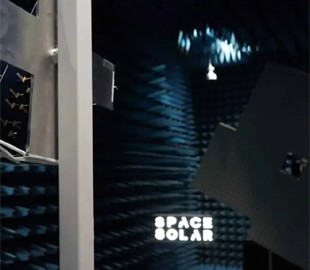
Space power plant projects face a whole range of engineering challenges. One of them — transfer of energy collected by solar panels to geostationary orbit, Earth. The British company Space Solar not only proposed a concise technical solution, but also conducted successful tests of its reduced prototype.
At first glance, there is nothing technically impossible in the idea of a solar power plant that transmits energy to Earth. We take photocells, assemble a huge battery from them, connect them to a microwave emitter and send them to geostationary Earth orbit (GSO). The rocket only needs more, but reliable collapsible trusses to support the colossal panel areas. It seems simple, but it is hidden in the little things.
For example, a satellite on DSO only looks rigidly "hanging" for an observer from Earth. It still moves in an orbit around the planet. So, so that its panels are always facing the Sun, it needs to rotate. At the same time, the emitter of microwave radio waves must maintain its orientation to the Earth, otherwise what is the point of the whole prank. Simply put, the antenna must be fixed on a hinge to transmit energy. The bad thing is that any mechanic performs very poorly in the conditions of open space, and it is extremely difficult to make it reliable.
Startup Space Solar from Great Britain solved this problem radically. She created a new emitter capable of continuously focusing a radio beam in any direction. In a recent press release on its website, the company talked about testing a prototype of such a device. The tests were carried out in a laboratory at Queen's University in Belfast. The development confirmed the workability of the concept, the radio beam hit the target regardless of the orientation of the emitter, and its characteristics (positioning accuracy, diameter) were always in the required range.
The innovative emitter is calledHarrier, its reduced version with a diameter of 50 centimeters was tested in the laboratory. The final project involves the creation of an antenna with a diameter of 1.7 kilometers, capable of transmitting gigawatts of energy from space to Earth. In addition, Space Solar plans to use its development and ground devices.
The details of the technology and the power of the tested device are not disclosed. As far as we can judge from the photos published by the company, the Harrier is an active phased grating of a complex shape, placed on a flattened cylindrical truss. This construction implies a circular "review" 360-degree radio beam, but not spherical — there are inevitable dead zones above and below the cylinder.
Not only the efficiency of the promising space power plant, but also its safety depends on how precisely the Harrier can form the beam. Few people would want gigawatts of energy to miss a receiving antenna on Earth.
In its press release Space Solar reported few details, only shared the success of the tests. However, the project is closely monitored by the UK space agency, whose representative was present at the prototype test. It can be assumed that the Harrier meets the minimum safety requirements for the future product.

